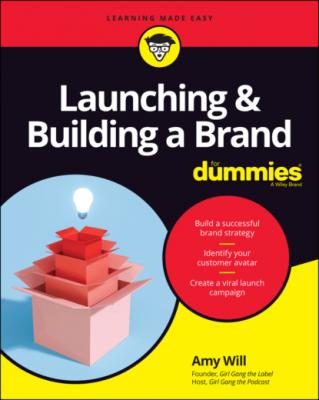Launching & Building a Brand For Dummies. Amy Will
Чтение книги онлайн.
Читать онлайн книгу Launching & Building a Brand For Dummies - Amy Will страница 24

Integrity
Diversity, equity, and inclusion
Relationships
Another approach is to write value statements, which are more like principles or policies, such as the following:
Do the right thing.
Have fun.
Deliver the highest-quality products and customer service possible.
Treat customers as they would like to be treated.
Protect and preserve the environment.
Exploring your brand’s personality
If your brand were a person, what kind of person would it be? Sexy and sophisticated? Young, hip, and sassy? Rugged and outdoorsy? Successful and charming? Bold and creative? Brand personality is the set of human traits attributed to a brand. You want your brand to have a readily identifiable personality that appeals to your target market. Here are a few brands that have strong personalities:
| Brand | Personality |
|---|---|
| Amazon | Reliable, trustworthy, responsive |
| Apple | Cool, creative, sleek |
| Coca-Cola | Enthusiastic, fun-loving, social, approachable |
| Harley-Davidson | Rugged, rebellious |
One way to identify your brand’s personality is to look at brand archetypes (common personality types), such as the following:
Artist/inventor
Caregiver
Explorer
Friend
Smart
Hero(ine)
Innocent
Magician
Minimalistic person
Confident
Leader
Writing your brand identity statement
When you have an intimate understanding of “who” your brand is — its mission, vision, values, and personality — you’re ready to formalize it in the form of a brand identity statement. In this section, I lead you through the process.
Covering the essentials
When writing your brand identity statement, make sure that it includes the following essential elements:
Your brand’s name or tentative name: Discussed in the later section “Naming Your Brand”
Your brand’s point of differentiation: What your brand offers that’s better than the alternatives
Your target market: The people you most want to be enthusiastic about your brand
Your brand’s mission or vision: Its purpose
Your brand’s values: The one or two at the top of your list
Your brand’s personality: Traits that you express in words or in the tone of your brand identity statement
Structuring your brand identity statement
Your brand’s identity is its essence — its lifeblood. This identity is communicated through the brand’s name, logo, tagline, content marketing, advertising, signage, and public engagement.
Your brand identity statement guides everything you do to develop the brand identity you want to project. This statement must cover all the essentials listed in the previous section clearly and succinctly. Here’s a template for structuring your brand identity statement, but don’t feel locked into it:
[Brand name] offers [point of differentiation] to [target market]. We are committed to [mission] through [values] with our [brand personality].
Here’s an example:
Athletipro offers a quick and easy online shopping experience and speedy delivery of equipment and supplies to amateur and professional athletes and everyone in between. We’re committed to empowering each customer to achieve optimal health, fitness, and performance through research and innovation with our unequaled passion and drive.
Testing your brand identity statement
Before you invest time and effort developing a brand consistent with your brand identity statement, put it to the test. Seek feedback from others within your organization and from people outside your organization, preferably from existing or prospective customers in your target market. But you can consult friends and family members if the other options aren’t available.
As you gather feedback, use it to answer the following questions:
Does your brand identity statement resonate with people and appeal to what matters most to them? If not, find out what would appeal to them.
Is the promise (mission) conveyed in your brand identity statement realistic, and can your brand deliver it consistently? If you’re talking to existing customers, ask them whether they think your brand is living up to its promise.
What’s the brand’s perceived personality, and how does it compare with how you want your brand to be perceived?
What do you think you need to do to bring people’s perception of your brand more in line with the brand identity you envision?
Naming Your Brand
Now more than ever, you need to catch the attention of prospective